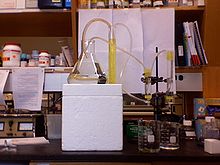- Columnmaster 4000
-
The Columnmaster 4000 is a piece of laboratory equipment designed for use in automating column purification (a type of protein purification[1]). Based on easy-to-understand physical concepts, the simple design of this instrument and the ready availability of its components in most laboratory settings makes the Columnmaster 4000 a popular choice for accurately delivering a series of washes to the column. Its use, however, is plagued by mishap and error hampering the original purpose to which it was created. The result is for many to refer to the column as a "retarded monstrosity."
Contents
History
The Columnmaster 4000 was first conceived as a crude assemblage of glassware during a summer research period at the College of Wooster[2].It was assembled from everyday glassware in an attempt to ease the notoriously tedious task of regenerating chitin columns for re-use. Due to the crude nature of the instrument, however, perfecting the design was difficult, as slight miscalculations in water level could lead to the loss of valuable column material. However, when more precise glassware was used, results improved significantly, and it was soon accepted by researchers working on multiple projects involving the use of chitin columns.
Controversy
Originally proposed by Roger Klein, a very gifted and talented individual, the Columnmaster 4000 quickly became the subject of a hot debate surrounding its efficacy. While, in principle, the column would be an effective tool in semi-automating a tedious purification procedure, the device failed to perform adequately during testing. Klein's support for the project was met with great opposition by his laboratory supervisor, Chris Nau. Nau pointed out that not only did the use of the column require more work during its set up, running, and break down than running chitin columns by hand, but also increased the chance of error during purification. Possible exposure to contaminants, resulting from glassware and rubber hosing was also cited as a disadvantage of this technique.
As of yet, the Columnmaster 4000 has yet to successfully be used in the application of column chromatography.
Mechanics
The idea for the Columnmaster 4000 is based on the simple physics principle of gravity, cohesion, and adhesion. The end of the tube (where the water exits) must remain lower than the beginning of the tube (where the water enters). Thus, the water level of the target container, in this case, the column, will remain equal to the water level of the source flask. Using a source flask with a diameter significantly greater than the column will allow large amounts of liquid to pass through the column without a significant drop in the level of the column, ensuring that the bed of the column will not go try.
Advantages
The primary advantage of the Columnmaster 4000 is its ability to deliver liquid to the column without disturbing the column bed. Such disturbances could lead to unacceptable mixing of two column washes, resulting in decreased purity of the sample on the column. Because the Columnmaster delivers water only as fast as the solute level is depleted, excess liquid is not delivered before it in needed, minimizing backflow and dilution. Another key advantage to using the Columnmaster 4000 is the ability of the researcher to leave the column for extended periods of time without the concern of overflow. The user can control the water level based on the positioning of the tubing. Multiple column volumes can be added based on the amount of liquid the user puts into the source vessel, which they can do all at once (as opposed to in small aliquots, as was previously necessary to ensure proper switching between washes.)
Criticisms
It has been claimed that the Columnmaster 4000 has issues with sterility. Due to the rubber nature of the tubes used, the adhesion of proteins is thought to be a possible source of contamination. Other criticisms include the lack of an auto-off feature. The addition of such a feature would allow the user to be sure that the column material would not go dry, and thus, eliminate the risk of large-scale protein loss.[3]
References
1) http://hhmi.wooster.edu/COWJRERE/OverviewERE-08.html 2) Roe, S. "Protein Purification Applications" Oxford University Press. 2001. 3) http://www.proteinscience.org/cgi/content/full/17/4/736
References
Categories:
Wikimedia Foundation. 2010.

